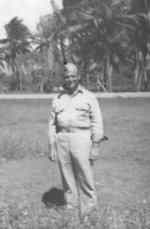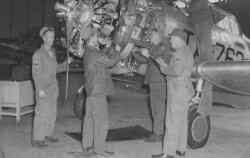Page 1
Day 285
Bad day. Dysinger died.
My best friend, Dysinger, died of diphtheria in the camp this
winter. The ground was frozen so deep, the bodies of dead prisoners
have to be stacked inside a house until spring thaws the ground and they
can be buried.
When is this ever going to end?
13 months earlier… Dec. 8, 1941
 Dysinger
and Russ walked out of the PX at Nichols Field. Russ raised his drink bottle
to his mouth and looked skyward. Planes screamed downward and some men
yelled, "Look, navy planes!", but Russ dropped his drink and
both men hit the ground. Bombs exploded on either side of them,
killing some and injuring others. The war had begun. Dysinger
and Russ walked out of the PX at Nichols Field. Russ raised his drink bottle
to his mouth and looked skyward. Planes screamed downward and some men
yelled, "Look, navy planes!", but Russ dropped his drink and
both men hit the ground. Bombs exploded on either side of them,
killing some and injuring others. The war had begun.
At 11:27 a.m. the silver medium range bombers with red rising
suns painted on their wings headed toward Cavite Naval Base. The
attackers main base was Formosa (now Taiwan). To defend the islands,
there were only 160 U.S. aircraft. 35 of which, were Boeing B-17
Flying Fortress bombers. Quite useless for defensive purposes.
The Japanese bombers circled the naval base twice,
then leveled off and dumped their fiery destruction. Another formation
passed over Manila and hit Nichols Field with demolition and incendiary
bombs. The fuel dump took a direct hit. Most of the U.S. aircraft
were lined up in a straight row making for easy prey by the Jap bombers.
Only a small number survived to get off the ground. Russ
never knew why the aircraft had not been concealed, for they had been on
alert for over a week and were sleeping under the
planes. The Americans lost 86 aircraft against 7 Japanese Zero fighters
shot down.
Day 215 - Mukden, Manchuria
We arrived in Mukden in mid-November 1942. Winter!
Mukden was built on the presumption that Japan not
only would win the war but would keep many prisoners at work for years
to come. When we arrived at Hoten compound, the Japs told us that
if we obeyed orders for the next 10 or 20 years to come, our relatives
would be permitted to visit us!
Hoten compound is a work camp of
about 1,500 enlisted POW’s. There are many other such compounds in Japan
and other areas.
We are placed in barracks that had once been chicken
houses. There is very little heat and the winters in Manchuria
go down to 40 degrees below zero, so I slept with all
of the clothes I owned and even leave my shoes on, trying to keep warm.
The prisoners sleep on hard benches. There
are not any tables or chairs. Many times throughout the winter, snow has
to be shoveled from the roofs of the barracks to keep them from collapsing.
It takes courage to wash your clothes in winter, Plunging our scaly,
red hands into the icy water. But clean clothes are such a rarity,
one has to do it.
With no utensils, I made a spoon from a piece
of drainage pipe. We have small wooden bowls for our fish heads and
rice. I have to hunt constantly for food. I trade cigarettes for fish that
others would not eat. I see so many men just absolutely refuse to eat.
They just sit down and die. I try bribery on them, offering cigarettes
for each bite they eat, to see if I can't help some of them fight off starvation,
but it is a losing battle for most. With winter in full fury, there is
little to eat besides the handful of bug infested rice and rotten fish
scraps that the Japs give out.
Day 262
Its almost Christmas, I think. Its hard to tell exactly what day
it is. No one has a calendar.
Christmas, 1941
On the morning of December 22nd came over 43,000 troops from the enemy
vessels. Not a bomb, not a torpedo came from the Americans. No American
bombers or any presence of American sub-marines were observed. The
main Japanese invasion of the Philippine Islands had begun.
General MacArthur's War Plan, known as Orange No. 3
(or WPO-3) , a 20 year old plan, stated that
in the event of a successful Japanese landing on the main island
of Luzon, the Philippine Division and the Philippine
Army, if unable to beat off landings and advances of the enemy,
were to fight delaying actions and withdraw into
Bataan Peninsula. The plan envisioned a six month stand by which
in time, aid from the United States would arrive.
 MacArthur's
plan, written in 1928, was based on a major defense at the beaches. They
were to catch the enemy when transports were close to shore. After locating
the landings, the navy and air corps would engage
the convoy and then artillery would bombard the beaches and infantry would
mop up any remaining troops reaching shore. But this plan was altered.
There would be only a relatively small defense at the beach. Delaying
actions were to be fought while the bulk of the forces dropped back to
Bataan. Holding Bataan was their main goal. Artillery batteries pounded
the enemy, but did little to slow the advance. MacArthur's
plan, written in 1928, was based on a major defense at the beaches. They
were to catch the enemy when transports were close to shore. After locating
the landings, the navy and air corps would engage
the convoy and then artillery would bombard the beaches and infantry would
mop up any remaining troops reaching shore. But this plan was altered.
There would be only a relatively small defense at the beach. Delaying
actions were to be fought while the bulk of the forces dropped back to
Bataan. Holding Bataan was their main goal. Artillery batteries pounded
the enemy, but did little to slow the advance.
We set about destroying equipment and supplies we no longer could use.
Large tanks full of aviation and diesel fuel were being burned. I asked
a lieutenant if we could pour gasoline into the bay and set
it on fire to perhaps hinder a few of the troops coming ashore but was
told that this would be cruel and inhumane!
If only he realized what lay ahead.
|